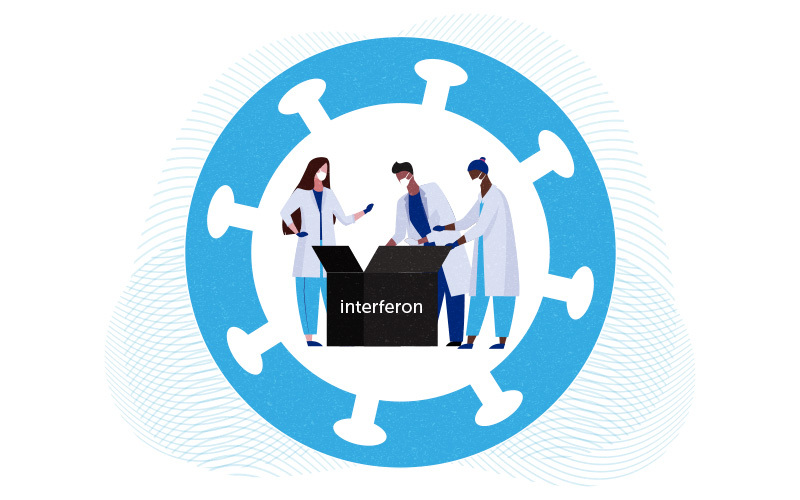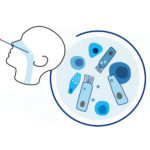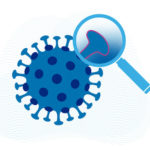Unpacking the body’s interferon response to COVID-19

Interferons are potent natural antivirals, rallying other parts of the immune system to defend against viruses. Some clinical trials have tested interferons as a treatment for COVID-19, but results have been mixed. And the science has been unclear about whether interferons are helpful or harmful.
Key takeaway
An early, protective interferon response in the upper respiratory tract is associated with mild COVID-19. Without such a response, SARS-CoV-2 can spread to the lungs, where a different, harmful interferon response contributes to severe inflammation and tissue damage.
New research in the journal Cell, led by Ivan Zanoni, PhD, an immunologist at Boston Children’s Hospital, provides a more complete picture of interferons’ role in mild versus severe COVID-19, informing future research and, potentially, treatment.
“We think what we’ve found could change the view of interferons in COVID-19, and may be useful for designing more defined therapeutic interventions,” says Zanoni, who is co-senior author on the paper.
The importance of location and timing
The general scientific view has been that severe COVID-19 results from a delayed, weakened interferon response to SARS-CoV-2. Building on a study published last year, Zanoni and colleagues show a more complex picture: Interferons play differing, even opposite roles in the upper and lower respiratory tract, and different types of interferons have different effects.
“We show how the production of specific interferons determines the severity of COVID-19,” says Zanoni. “Disease severity also depends on when and where they are produced.”
Zanoni, with co-senior author Nicasio Mancini, MD, of San Raffaele Hospital (Milan, Italy) and first authors Benedetta Sposito and Achille Broggi, PhD, in the Zanoni Lab, analyzed nasopharyngeal swab samples from 170 patients in Italy with mild COVID-19 and 31 controls who tested negative for the virus. They also studied bronchoalveolar lavage samples from the lungs of 56 patients with severe COVID-19, nine patients with severe lung disease from other infections such as influenza, and 56 patients with severe lung disease of non-infectious causes.
Using RNA sequencing and protein analysis, the team identified the specific types of interferon being produced in different parts of the respiratory tract and what kinds of genes turned on in response.
Interferons in the upper respiratory tract
Analysis of swabs from the nose, throat, and mouth showed that:
- Interferon is produced only when the viral load, or amount of virus present, exceeds a certain threshold. But high viral load itself did not correlate with disease severity.
- People with mild COVID-19 produce more interferons in response to high viral loads than people with severe disease, and younger people produce more interferons than people 70 or older. “The correlation between viral load and interferon production in the upper airways disappears in older people, and likely helps explain why older people get sicker,” says Zanoni.
- People with mild vs. severe COVID-19 produced different types of interferon in the upper airways. Those with mild COVID-19 produced high levels of two Type 3 interferons — lambda 1 and lambda 3 — which have a protective effect. “If you have lambda 1 and 3, you upregulate about 50 genes that restrict SARS-CoV-2,” says Zanoni.
- In contrast, patients with more severe COVID-19 produced predominantly Type 1 interferons and the Type 3 lambda 2 interferon. These appear not to be protective. “These patients did not show stimulation of genes that protect against the virus,” Zanoni notes.
- Consistent with findings earlier this year at Boston Children’s, the protective interferons were made by epithelial cells in the nasopharynx.
Interferons in the lower respiratory tract
Bronchioalveolar lavage samples from people with severe COVID-19 revealed high levels of interferons in the bronchi and lungs as compared to patients with other forms of severe lung disease. But these were mostly Type 1 interferons and the Type 3 interferon lambda 2, which, again, are not protective.
“There was no signature of antiviral genes,” says Zanoni. “Instead, there was a signature associated with cell death (apoptosis) and decreased cell proliferation. We believe these interferons are part of the detrimental pro-inflammatory response seen in severe COVID-19.”
The study also looked at interferons in patients’ blood, but found no correlation with interferon production in the lung.
Overall, the study supports the view that an early, protective interferon response in the upper respiratory tract is associated with mild COVID-19. Without such a response, SARS-CoV-2 can spread to the lungs, where a different, harmful interferon response contributes to the severe inflammation and tissue damage typical of severe COVID-19.
“Our findings reconcile a large portion of the literature on interferons, and further stress the key role played by interferon 3, compared to interferon 1, during life-threatening viral infections,” the researchers write.
Treatment implications?
The study observations suggest that patients could benefit from Type 3 interferons given locally, as in a nasal spray, early in the course of SARS-CoV-2 infection. This, however, raises logistical questions. While Type 3 interferons are clinically available, they are expensive drugs with potential side effects and would need to be prescribed by a medical professional. By the time a patient feels sick enough to see a doctor, the treatment window may have closed.
“I think vaccines are still the best way to protect people,” Zanoni says.
But at the other end of the spectrum, the study supports the idea of using drugs to block harmful interferon signaling later in the lungs, he adds.
The study was funded by the National Institutes of Health, the Lloyd J. Old STAR Program, the Burroughs Wellcome Fund, and the Wellcome Trust. Zanoni reports compensation for consulting services with Implicit Biosciences.
Explore COVID-19 research at Boston Children’s Hospital
Related Posts :
-

Why do some children get MIS-C after COVID-19? Some early clues
Several months into the COVID-19 pandemic, a small number of children began to develop a cluster of mysterious symptoms. These ...
-

Rapid saliva test detects COVID-19 variants, at home or point of care
COVID-19 tests are now widely available, including FDA-approved tests like BinaxNOW that people can do at home. But none of ...
-

Why do some people get severe COVID-19? The nose may know
The body’s first encounter with SARS-CoV-2, the virus behind COVID-19, happens in the nose and throat, or nasopharynx. A ...
-

Sturdier spikes may explain SARS-CoV-2 variants' faster spread
The fast-spreading U.K., South Africa, and Brazil variants are raising concerns and questions about whether current COVID-19 vaccines will ...





